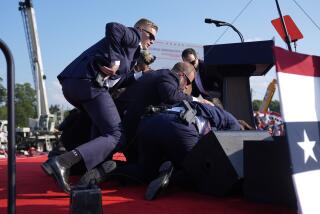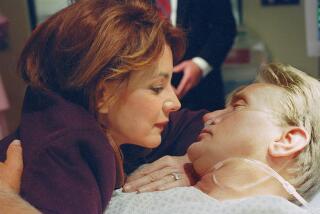A look inside Hollywood and the movies : ‘Line of Fire’ Gives Crowd Control a New Meaning
George Bush may not know it, but that’s Clint Eastwood who’s guarding him on the Tarmac at Andrews Air Force Base in a scene from “In the Line of Fire.” It’s just that Bush is unrecognizable and Eastwood, as Secret Service agent Frank Horrigan, was never actually there.
Using computers, the face of actor Jim Curley, who plays the President in the movie, was digitally superimposed over Bush’s, and Eastwood, seen scanning the crowd for possible assassins, was matted into the footage months after Bush lost the election to Bill Clinton.
“Jurassic Park” meets Campaign ’92.
The same technology that effectively integrated computer-generated images of rampaging T. rexs with real actors in the Spielberg blockbuster has been used, some might say, to even an eerier extent in the new thriller from Columbia Pictures and director Wolfgang Petersen.
Eastwood, playing an aging agent who is psychologically burdened by his inability to prevent John F. Kennedy’s death 30 years before, tracks a current would-be presidential assassin (John Malkovich) with a vengeance. Shots of Eastwood, plus those of many extras, were melded in with those of people filmed by second-unit crews that followed the Bush and Clinton entourages during last fall’s presidential campaign. Other objects, like campaign placards, were masked or disguised.
The seemingly seamless matching of images leads “In the Line of Fire” producer Jeff Apple to predict “a time in the not-so-distant future where an actor who might have been killed (while making a movie) could be cloned electronically for scenes that were never completed.”
As creepy as that sounds, the technology worked to convincing effect for this production. A couple of examples:
* Eastwood as a young agent is seen in the background as Jack and Jackie Kennedy press the flesh with supporters after they touch down at Love Field in Dallas prior to their ride into town that fateful Nov. 22, 1963. After Eastwood appealed to Warner Bros. President Terry Semel, footage of the actor from the 1971 Warners movie “Dirty Harry” was made available and then retrofitted to the fashion of the previous decade. Eastwood loses the longish hair and sideburns or, as Apple describes it, “gets the world’s first digital haircut.”
* A huge Bush rally was transformed into a rally for the generic “In the Line of Fire” President by replacing the word Bush on campaign signs with the words Four More Years . Clinton rallies that were usually smaller and less well-organized than those of his opponent, Apple recalled, were made bigger and more boisterous by adding computer-generated extras to the crowds.
To achieve such a level of verisimilitude requires 50 megabytes of information per frame at 24 frames per film second to reconfigure by computer a particular shot into digital format, calculate and time the changes and alter the frame to accommodate the new images. The process gets into gigabytes after a few seconds. Cost: $300 per frame. Or, “very, very expensive,” in Apple’s words.
Sony Image Works, RGA/LA and Cinesite were the key computer houses that did special effects on the film, and were estimated to cost as much as 10% of the movie’s $40-million production budget. The houses worked simultaneously in order to complete the picture--principal photography lasted from October through January--in time for a summer release.
Although the production got full cooperation from the Secret Service to position its VistaVision and Panavision cameras at secure points at campaign rallies and along motorcades--over cries of favoritism by the White House media corps, apparently--the filmmakers needed Air Force One for a nighttime establishing shot. Knowing they never would be allowed to use the Presidential jet (estimated worth: $500 million), computer graphics provided movie magic showing the jet flying through a rainstorm. Just a few years ago, Apple laughs, the same scene might have looked like something out of “Airplane!” if shot conventionally using a model.
The filmmakers did mount a Presidential motorcade of its own in the streets of Washington, with Eastwood on hand to run alongside the President’s limousine, but otherwise the statuesque Oscar-winning actor did most of his steely-eyed protective work before a blue screen on a sound stage in Culver City.
Apple conceded that if Eastwood had appeared at campaign rallies with either Bush or Clinton, his presence might have caused supporters to stare at him instead of the candidate--thereby ruining the shots for the movie.
More to Read
Only good movies
Get the Indie Focus newsletter, Mark Olsen's weekly guide to the world of cinema.
You may occasionally receive promotional content from the Los Angeles Times.










